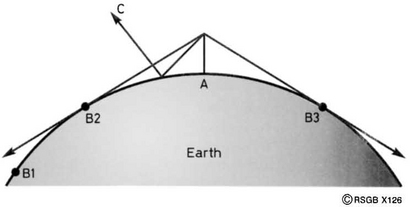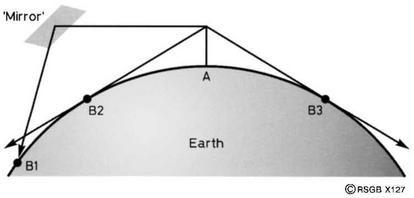Waves – Part 2
Getting weaker
Imagine a torch battery connected to a bulb by wires about 1 metre long. The bulb lights normally. If we now take the bulb 100 metres away from the battery and wire it up, we would expect the bulb to be somewhat dimmer, which is exactly what would happen. It happens because of the resistance of the wires – the wires do not form a perfect conductor. A similar situation occurs with radio waves.
All waves suffer from attenuation – they get weaker the further they travel. In cases of extreme attenuation, we need to apply some amplification before the attenuated wave can be used in a receiver.
Carrying information
When we speak over the telephone, the range of frequencies in our voices extends from very low frequencies up to about 15 or 20 kHz. In audio terms, this is quite a large bandwidth (meaning a wide band of frequencies). For communications purposes, however, most of this bandwidth is not needed, and in the telephone system (and in our transceivers), this is cut down so that it extends from about 200 Hz to 3 kHz, a reduction in bandwidth from 20 kHz to about 3 kHz. A bandwidth of 3 kHz has been found to be sufficient to convey speech intelligibly which, after all, is just what we need!
The radio waves coming from an amateur transmitter convey our speech signals over long distances. By themselves, the speech signals do not travel very far, so they have to be combined with a radio signal that will travel long distances. This extra signal is called the carrier wave (or just the carrier), because its job is to carry the speech signals along with it! The process of combining the speech (or Morse code) with the carrier is called modulation.
Wider and wider
Sending Morse code is achieved simply by switching (or keying) the carrier on and off. The bandwidth of the transmitted signal is only about 100 Hz. Speech, with its reduced bandwidth of 3 kHz, will produce a single-sideband (SSB) transmitted signal with a bandwidth of 3 kHz. If the same speech signal were used to produce an amplitude-modulated (AM) signal from the transmitter, it would have a bandwidth of about 6 kHz. Perhaps you can now understand why the bandwidths needed to produce hi-fi broadcasts need to be so large. TV signals need bandwidths running into tens of megahertz!
Waves need aerials
Radio waves are produced whenever changing currents flow through a wire, and when that wire is made in such a way as to maximise the radiation from the wire, it is called an aerial or antenna. The same piece of wire will receive radiation from other aerials; an aerial will transmit and receive. This is an important property of the aerial: when a current flows through it, electromagnetic waves are launched into the air; when electromagnetic waves in the air encounter the aerial, currents are produced in it.
From the simplest transmitting aerial, waves travel in all directions, like the waves on the pond that we considered in Part 1. They will travel a long way through air and space before they become too week to be received. They won’t travel very far into the earth, however! The earth will reflect some of the wave and will absorb the rest. That portion of the wave which is reflected will again travel through air and space until it is totally attenuated.
Look at Figure 1; A represents a radio transmitter, with B1, B2 and B3 being receiving stations. The two arrows pointing ‘downwards’ from A represent two of the waves from A which just graze the earth’s surface. Waves above these will travel on into space; waves below them will either be absorbed and reflected by the earth or received by aerials. B1 will not receive any signals from A, because it is below A’s horizon. B2 and B3 can receive A’s signals because they are just on A’s horizon. Any stations between B2 and B3 will also receive A’s signals, which are known as ground-wave signals. The wave at C represents one which is reflected by the ground and travels into space.
This description begs the question of how signals are received from stations well beyond the ground-wave range.
Mirrors in space
Suppose that there was something, out in space, that would reflect radio waves. Waves from A that travel out into space could be reflected off it and return to earth, enabling stations such as B1 to receive A’s signals. The situation just described is illustrated in Figure 2.
Just such a mirror in the sky really does exist. It is not man-made, of course! The earth is surrounded by the atmosphere, a mixture of many gases, such as nitrogen and oxygen. The energy contained in the radiation from the sun is more than sufficient to ionise these gases, thus making them into electrical conductors. When a gas is ionised, some of its electrons are physically stripped out of the atoms and are free to move about, just as the electrons of a metal do in a wire. Consequently, we can regard this part of the atmosphere (the part illuminated by the sun) as acting like a sheet of metal, which reflects radio signals! It is not a perfect reflector, but is sufficient to produce long-range (DX) radio propagation via the sky wave under the right conditions. (A more down-to-earth example of ionised gases conducting electricity can be found in the fluorescent tube and the neon sign – many gases glow when they are continuously ionised.)
This conducting region at the extremity of the atmosphere is called the ionosphere, and it exists in layers between 60 km and 700 km above the earth’s surface. When the ionosphere is sufficiently ionised, it glows; this is the natural phenomenon known as the aurora borealis, or the northern lights.
The property of the ionosphere that enables radio waves to be reflected does not act in a uniform way; it is very selective about which waves it reflects, and which waves go straight through it and into outer space. In general, it reflects only those waves with frequencies below about 30 MHz – the HF bands!


